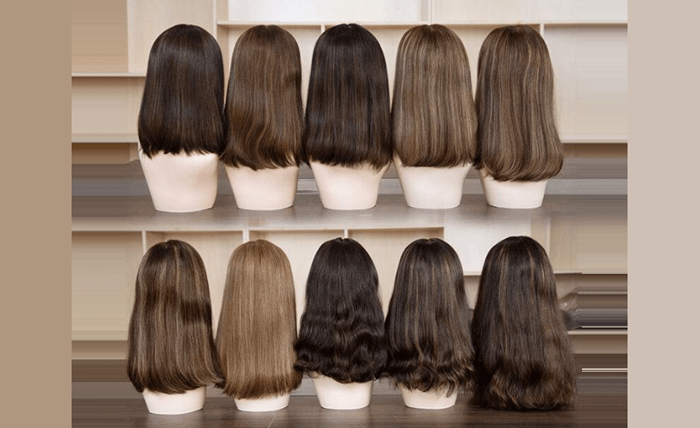
The nuances of religious practices often find material expression in various forms, reflecting cultural adherence to tradition.
A Jewish wig is traditionally called a “sheitel,” used predominantly by married Orthodox Jewish women as a fulfillment of modesty laws requiring the covering of hair in public. It allows women to maintain privacy, following religious directives of tzniut (modesty).
Understanding the cultural significance of such practices offers insight into the personal observances of religious identity.
What are the rules for Jewish wigs?
Appreciating intricate religious customs involves comprehending the tenets and regulations that guide practices.
The rules governing Jewish wigs primarily concern modesty, ensuring the wig appears natural yet not overly provocative or attention-drawing. Customarily, the sheitel should not be an ornament but should reflect the commitment to religious precepts of modest attire.
Key Guidelines:
– Modesty Focus: Ensures adherence to traditional values.
– Natural Appearance: Avoidance of flamboyance.
– Religious Compliance: Reflects dedication to tzniut.
Observance of these rules underscores communal identity and personal devotion to traditional norms.
Why can Orthodox Jews wear wigs but not show hair?
Navigating religious mandates often involves understanding symbolic practices within cultural frameworks.
Orthodox Jewish women wear wigs to fulfill religious obligations of modesty by covering their hair, as the wig distinguishes between private and public appearances. This adheres to tzniut principles, combining modern alternatives with ancient traditions for discretion and distinction from their unmarried counterparts.
Symbolic Practice:
– Public vs Private: Distinction in appearances for modesty.
– Continuity of Tradition: Balances contemporary and historical values.
– Cultural Identity: Reinforces communal inclusivity.
These symbolic articulations of practice convey shared values emulated through generations.
What makes a wig kosher?
Determining adherence involves discerning religious and ethical benchmarks defining acceptable standards.
A kosher wig meets ethical standards of hair sourcing and manufacturing, aligning with religious precepts of modesty. Compliance in the context of wigs involves ensuring the Jewish law (halacha) approves the wig, which may include inspectors overseeing production processes.
Kosher Compliance:
– Ethical Sourcing: Obey ethical dictates for hair sources.
– Manufacturing Oversight: Ensures adherence to halacha.
– Campaigns for Assurance: Foster transparency and trust in production.
Ensuring these tenets fortifies attrition responsible conformity to religious standards.
Why do Orthodox Jews wear black?
Identifying cultural highlights through color depicts adherence reflecting broader theological tenets.
Orthodox Jews often wear black as it embodies modesty, simplicity, and conformity, aligning with religious prescriptions avoiding calls for attention. This color choice cross-generationally presents societal integration within traditional frameworks, maintaining conservative values.
Cultural Symbolism:
– Modesty and Simplicity: Avoid flamboyant expression.
– Symbol of Unity: Reinforces communal identity.
– Continuity of Tradition: Represents value consistency.
The perpetuation of these norms cements unity through clothing symbolism reflecting religious devotion.
Why do Jews keep their hair like that?
Cultural expressions of identity often manifest in specific formalties grounded in religious mandates.
Jewish men maintain traditional sidelocks or “payot” following Biblical directives and interpretations requiring non-disturbance of hair edges, mirroring noticeable allegiance to religious commands and community discipline.
Hair as a Practiced Symbolism:
– Biblical Interpretation: Aligns with religious scriptural readings.
– Distinct Community Mark: Differentiates religious observance visually.
– Perpetuated Tradition: Continuing historical customs symbolically.
Reiterating these patterns strengthens cultural endurance through generational representation.
Is a wig allowed in the airport?
Logistics intersect with cultural mandates in public areas where identification and compliance are crucial.
Wigs are permitted in airports globally, aligning with security n0Why do Jewish men have curls?
Religious mandates yield distinctive observable practices among faithful communities for identification and observance.
Jewish men wear curls, known as payot, following biblical injunctions directing hair growth avoidance at the head’s corners, signifying religious adherence and reinforcing covenant commitments. These curls visually demarcate communal solidarity and individual devotion.
– Communal Cohesion: Reinforces identity within religious circles.
– Covenantal Significance: Expresses lifelong religious commitment.
These coiffure practices reinforce generational perpetuity of religious bonds through observance.
Why do Jews cover their heads?
Symbolic gestures of faith manifest tersely through attires recognized within religious observance acts.
Jews cover their heads, typically with a kippah or yarmulke, recognizing divine presence, signifying respect and reverence. Head coverings differentiate spiritual consciousness, fostering reflective acknowledgments of humility before God uprightly worn in daily religious practices.
Reverential Practice:
– Symbol of Respect: Represents humility and acknowledgment.
– Spiritual Awareness: Cultivates constant reminder of presence.
– Daily Practice: Worn regularly upholding traditional values.
This emblematic practice among Jews promotes a unified theological introspection supported by historical continuity.
Conclusion
Jewish customs, from the significance of wigs to attire colors, rooted in religious laws guide daily lives, preserving tradition, identity, and cultural continuity. These practices offer rich insights into the texture of religious adherence, informed by scriptures and reflecting communal life and personal devotion.




